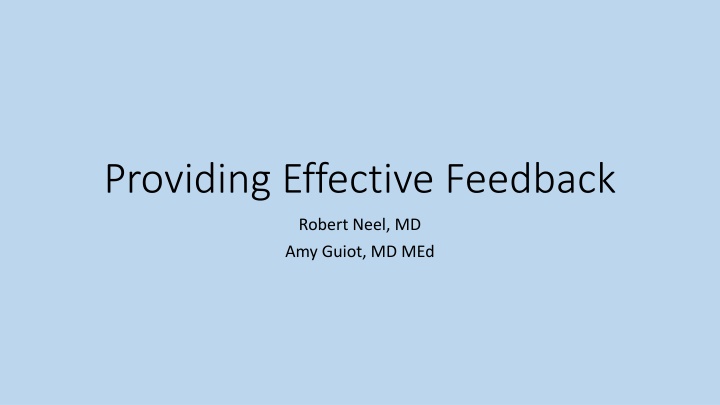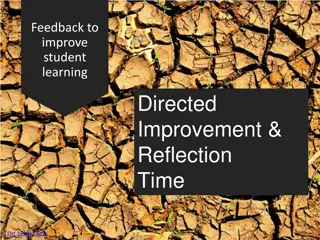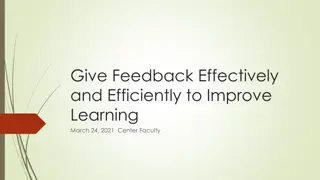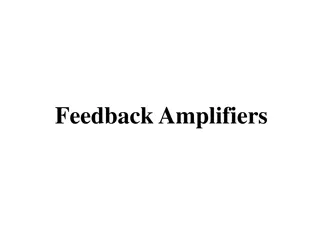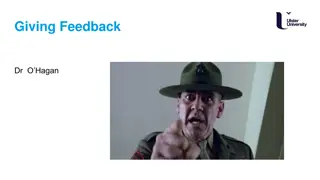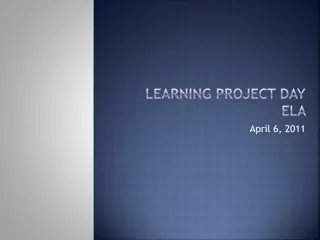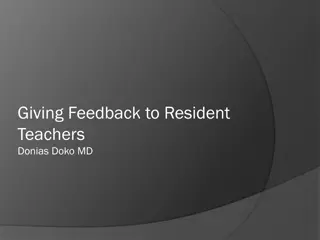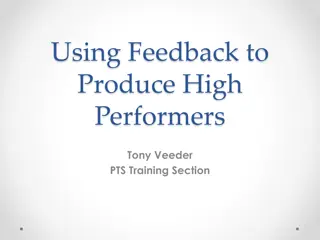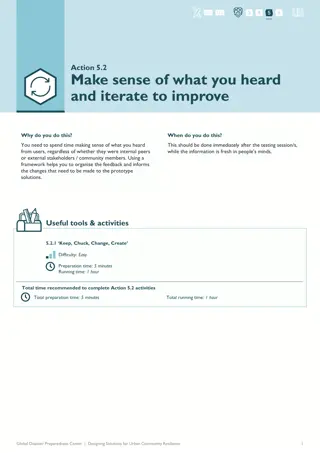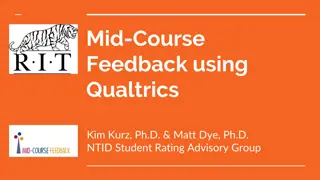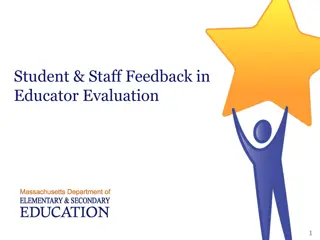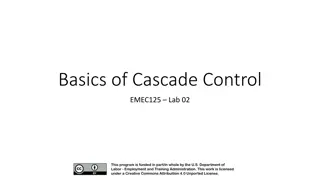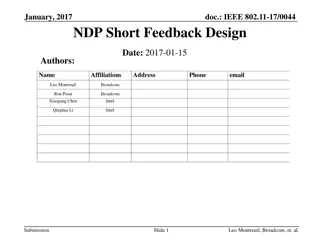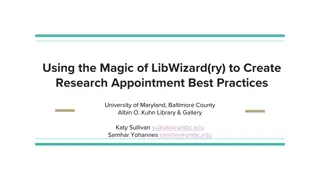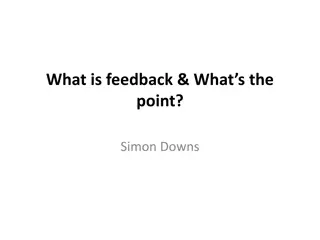Providing Effective Feedback
Discuss generational differences in evaluators and feedback recipients. Define and explore various types of feedback common in medical education. Learn how to improve the use of effective feedback in daily practice, especially in busy clinical settings.
Download Presentation

Please find below an Image/Link to download the presentation.
The content on the website is provided AS IS for your information and personal use only. It may not be sold, licensed, or shared on other websites without obtaining consent from the author.If you encounter any issues during the download, it is possible that the publisher has removed the file from their server.
You are allowed to download the files provided on this website for personal or commercial use, subject to the condition that they are used lawfully. All files are the property of their respective owners.
The content on the website is provided AS IS for your information and personal use only. It may not be sold, licensed, or shared on other websites without obtaining consent from the author.
E N D
Presentation Transcript
Providing Effective Feedback Robert Neel, MD Amy Guiot, MD MEd
Objectives Discuss generational differences in evaluators and evaluated Define Feedback Explain the various types of feedback common in clinical education settings Improve upon the use of effective feedback in daily medical educational practice Tips for giving effective feedback in a busy clinical settings
Baby Boomers Gen Y Silent Generation Gen X 5002000 4502000 Births (in millions) 4002000 Generational Approach to Evaluators and the Evaluated 3502000 3002000 2502000 2002000 1502000 1002000 502000 2000 1900 1920 1940 1960 1980 2000 2020 2040 Birth Year Modified from NASA and CDC Data
Howe, N. and Strauss, W. (2003), Millennials Go To College: Strategies For a New Generation on Campus: Recruiting and Admissions, Campus Life, and The Classroom, American Association of Collegiate Registrars and Admissions Officers, Washington, DC. Special Sheltered Confident Team-oriented Conventional Pressured Achieving
Baby Boomers (1944 1965) Television!!! McCarthy Hearings 54 Nuclear Family The Pill 60 and sexual liberation Cold War and the Cuban Missile Crisis ( 62) Assassinations of JFK ( 63) and MLK ( 68) Civil Rights, Women s Rights, Gay Rights Korean War, Vietnam War Space Race and the Man on the Moon 69 Rock N Roll, Woodstock 69 GI Bill and affordable college Life expectancy increases beyond previous generations
Baby Boomers Values and Work Ethic Service Oriented Driven by the legacy of World War II Uncomfortable with conflict Less nuanced feedback: good/bad Can be overly sensitive to feedback Can be judgmental of those who see things differently Positional authority Team Orientation Personal Growth Optimism Health and Wellness Involvement Personal Gratification Retirement mentality
Baby Boomers: How do you Work with them? Understand they respond to positional authority leadership style better Be gentle but not condescending with technology Do better with spoken communication style rather than email/written Give them time to change opinions and be patient with their opinions Remember the feedback mechanisms they involved Inner hippies vs conformist tendencies
Generation X (1965 1985) Television then VHS/Beta, the advent of computers Women s Lib, Gay Rights Watergate and the Energy Crisis 73 Three Mile Island and Iran Hostage Crisis 79 Disco, Punk Rock and Alternative Rock John Lennon Reagan MTV 81 and Saturday Morning Cartoons AIDS 84 Latch-key Kids Challenger Disaster 86
Generation X Values and Work Ethic Self-reliance Balance Diversity Thinking globally Techno-literacy Fun Informality Lean toward Pessimism More likely to work for institution than individuals Differentiate job from identity Flexible hours, informal work environment, less supervision Multi-tasking Handle multitude of tasks if given independence Accustomed to less feedback Referent authority, comfortable with authority but not titles
Generation X: How do you Work with them? Referent > positional authority leadership styles Beginning of the technology boom Bring in technology, but not 100% reliant Highest educational levels in generational cohorts Stress further training Stress balance between work and life Independence, quality of life measures Conversation and allow time to ask questions Latch key philosophy: Task list with minimal supervision, minimal feedback Be careful to balance compensation among peers
Generation Y (1985 - 2005 ) Television, Cable, Computers, Internet MTV Generation Reality Television Cellphones Columbine and Student Violence 9/11 and two wars in the Middle East Helicopter parenting Trophy Kids Boomeranging or Peter Panning Recession and Unemployment Debt and Rising Education Prices Google Social Media
Generation Y Values and Work Ethic Individualism Optimism Confidence/Ambitious Expecting Achievement Need for challenge Sociability Experiential learning On the job training Diversity Civic minded Always On Impatience (vs timely) Adaptability How you know vs what you know Given and expect much more feedback Seemingly always Multi-tasking Technological savvy Information Rich Mobility An Age of Insecurity? Comfort seeking?
Generation Y: How To work with them? Referent >> Positional Authority Appropriate balance between boss and team member Spell out expectations and goals, good orientation Structure Direct communication, realistic good and bad Mentor, help goal set Positive reinforcement and regular engagement Encourage team, and quality improvement Appreciate experiential learning, hands-on Timely responses! NOW! Allow for independence, flexibility in workplace Utilize their ability to multi-task, synthesize
Feedback - A Request from Internal Medicine Residents at UC
What is feedback? Feedback is designed to influence, reinforce, or change behavior, concepts or attitudes. Necessary and Expected Timely Specific Targeted to behavior Formative Based on direct observation Limited to 1-2 items Beverly Wood, MD Feedback: A Key Feature of Medical Training Radiology, 2000
Types of Feedback Informal Feedback (Feedback on the Fly) On the spot or soon after Observed knowledge, attitude or skill Offer tips on how to improve ( When you do the muscle strength exam, support the arm this way. ) Formal Feedback Set aside specific time (ex: given just after a clinic shift, end of day) Major Feedback Midpoint or end of a learning experience or rotation Serves to provide information to learner so they can improve before end of rotation
Feedback vs Evaluation Feedback (Formative) Timely, Immediate Informal Specific Actions Objective Content (specific behaviors observed) Subjective (descriptive feedback) Purpose: improvement, strengths and weaknesses, planning Evaluation (Summative) Scheduled, Usually End Formal Global Impression Objective Content (global) Subjective (descriptive evaluation) Purpose: improvement and grading, competence determinations
Feedback: Specific Examples Feedback: Specific Examples Good Bad Specific ( you could improve your reflex exam by ) Objective ( your presentation was too long and not focused on CC ) Behavior (yesterday, you forgot to dictate ) Too general ( you re not doing it right ) Subjective/ judgmental ( your presentation was terrible ) Personal ( you are just not reliable )
Compliment vs Positive Feedback Compliment Makes someone feel good You are doing a great job Positive Feedback Aimed at encouraging good performance That case presentation gave me detailed, useful information on how to diagnose and treat otitis media
Criticism versus Constructive Feedback Criticism Demeaning or belittling It s annoying when you are late You are too shy You are disorganized Your differential diagnosis was inadequate Constructive Feedback Aimed at improving performance You are often late I asked you for input you did not respond You included physical exam findings in your HPI Your differential diagnosis did not include hypothyroidism
Potential Problems with Feedback/Evaluation Potential Problems with Feedback/Evaluation Halo Effect Oops -Insufficient Evidence You never told me that! But I NEED Honors! Uh-Oh -Should they pass? Lake Wobegon Effect Southern NH AHEC. Evaluation: Making it Work Monograph
Barriers to Feedback Lack of knowledge about the learner Lack of skills on how to give feedback Lack of motivation (busy service or meetings) Non-supportive culture
Guidelines to Giving Feedback Step 1 Preparing the Learner Outline the expectations for the learner Establish an effective learning climate Clarify expectations the first day Communicate and share goals for the learning experience Review schedule Promote self-directed learning Alert learners to the use and not use of the Feedback word
Guidelines to Giving Feedback Step 2 Timing Prepare the learner to receive feedback Make it private Make it timely Actually say the word Feedback
Guidelines to Giving Feedback Step 3 Actually Stop and Give Feedback STOP and Give Feedback S=Specific T=Timely O=Observed behaviors P=Plan for action .\\beyond good job : How to give effective feedback. Pediatrics. M, Sa11 Feb;127(s):205-7. eb;127(s):205-7.
Guidelines for Giving Feedback Step 4 Confirm Feedback Received Understanding is confirmed to ensure clear communication Make sure it is understood (teach back or repeat back) One approach is to say to the learner, As a result of our meeting, tell me what you will do differently.
FEEDBACK SANDWICH Reinforcement Constructive Comments Reinforcement
The Feedback Sandwich NEGATIVE between POSITIVES Begin positive: This is what you re doing right! Insert small negative: These are some areas to improve End with positive: I m very pleased with Lang et al. Acad Med 2000; 1222-8.
Reinforcement Constructive Comments Reinforcement Learner Reflection
Ask Ask Tell Tell Ask Teach Ask Teach Modification of feedback sandwich Teacher s comments are preceded by learner s observation Allows for more detailed review than the sandwich Encourages learner to reflect on what should be maintained or developed regarding their own performance Cantillon J, Sargeant P. Giving Feedback in Clinical Settings. BMJ 2008; 337:1292-1294
Feedback Session Dr. Guiot Dr. Neel
Tips for Effective Feedback in Busy Clinical Settings Know Your Feedback Style Utilize Existing Frameworks for Feedback Moments of Mobility Feedback Fridays Notes and Census Notes Cellphone: notes and bar codes
Know Your Feedback Style Know Your Feedback Style(s) The Nurturing Mother The Army Sergeant The Scientist The Accountant The Comedian Know Your Learner s Style The soldier The active son/daughter The budding scientist The budding accountant Then know your learner s style ..
Utilize Existing Frameworks for Feedback Use the ACGME Core Competencies as a Framework Medical Knowledge Patient Care Interpersonal Communication Professionalism Practice Based Learning Systems Based Learning
Use the Core Competencies as a Framework: Specifics Medical Knowledge You pulled out the key medical facts very well. You don t seem very familiar with this topic. I would like you to read on it. Patient Care Your motor exam was excellent and you did a great job with localizing the innervation based on that. Your motor exam was not specific. I would like you to review the myotome exam again and use it as your exam focus on the next patient.
Use the Core Competencies as a Framework: Specifics Interpersonal Communication You kept the language simple and direct during that family conference. Great job. You used the word dysphagia five times without defining it for that family. Remember to use less of our jargon words. Professionalism You are always here on time and ready to work. That is great professionalism. Please work on being on time to rounds.
Use the Core Competencies as a Framework: Specifics Practice Based Learning The study you shared with the group really helped the treatment decision. When possible, go to the literature for guidance about treatment decisions. Systems Based Learning Contacting the patient s pharmacy was a great idea and really helped us help the patient. You should seek more collateral when giving a history on a patient who is altered.
Use the RIME as a Framework Reporter Interpreter Manager Educator
Use the RIME as a Framework: Specifics Reporter: You described the details of the history and exam correctly. Interpreter: You were able to tell me what that history and exam meant and create a differential. Manager: You were able to take that differential and with your knowledge of the patient, create an appropriate diagnostic and therapeutic plan. Educator: You were able to teach others about your process and make them understand it.
Moments of Mobility Before Ward Rounds During Ward Rounds In between rooms In between floors (the stairwell chat) Don t be afraid to use your cellphone for verbal notes with a learner! After Ward Rounds Walking Back from Educational Conferences Planned walking meetings
Feedback Friday: Specific Time Placement Agree on regularity of feedback: weekly, every 2 weeks What about shiftwork? Create a time/day for specific regular feedback Ultimate day vs penultimate day? Protect that time and treat it like clinical time for all, learners and teachers Find department buy in and champions Carrots and Sticks
Notes on Learners: The Census Model Keep a list of your learners on rotation with you Census model (daily notes) Learner Day 1 Day 2 Day 3 Day 4 Good history on patient X but not enough collateral. Exam was accurate. Differential was incomplete. Better history taking on pneumonia patient with important social and risk factor delineation. Appropriate management decision about HTN meds on Patient Z. Needs to read about calcium channel blockers. Learner 1 Detailed presentation on sarcoid. Missed the PE signs of CHF on Patient Y. Took feedback well. Demonstrated the CHF findings on Patient Y with me and how they had changed. Had read about management of CHF. Learner 2 Note cards (paper or electronic) Make daily notes on that list or on your patient census Keep those notes with you like you do your patient census Use that list at end of your tour of duty to give specific examples
Conclusions: Feedback Be undertaken with teacher and trainee working as allies, with common goals Be well timed and expected Be based on first hand data Deal with specific performance, not generalizations Offer subjective data, labeled as such Deal with decisions and actions, rather than assumed intentions or interpretations Ende, JAMA.1983;250(6):777-781
Questions? Questions?
